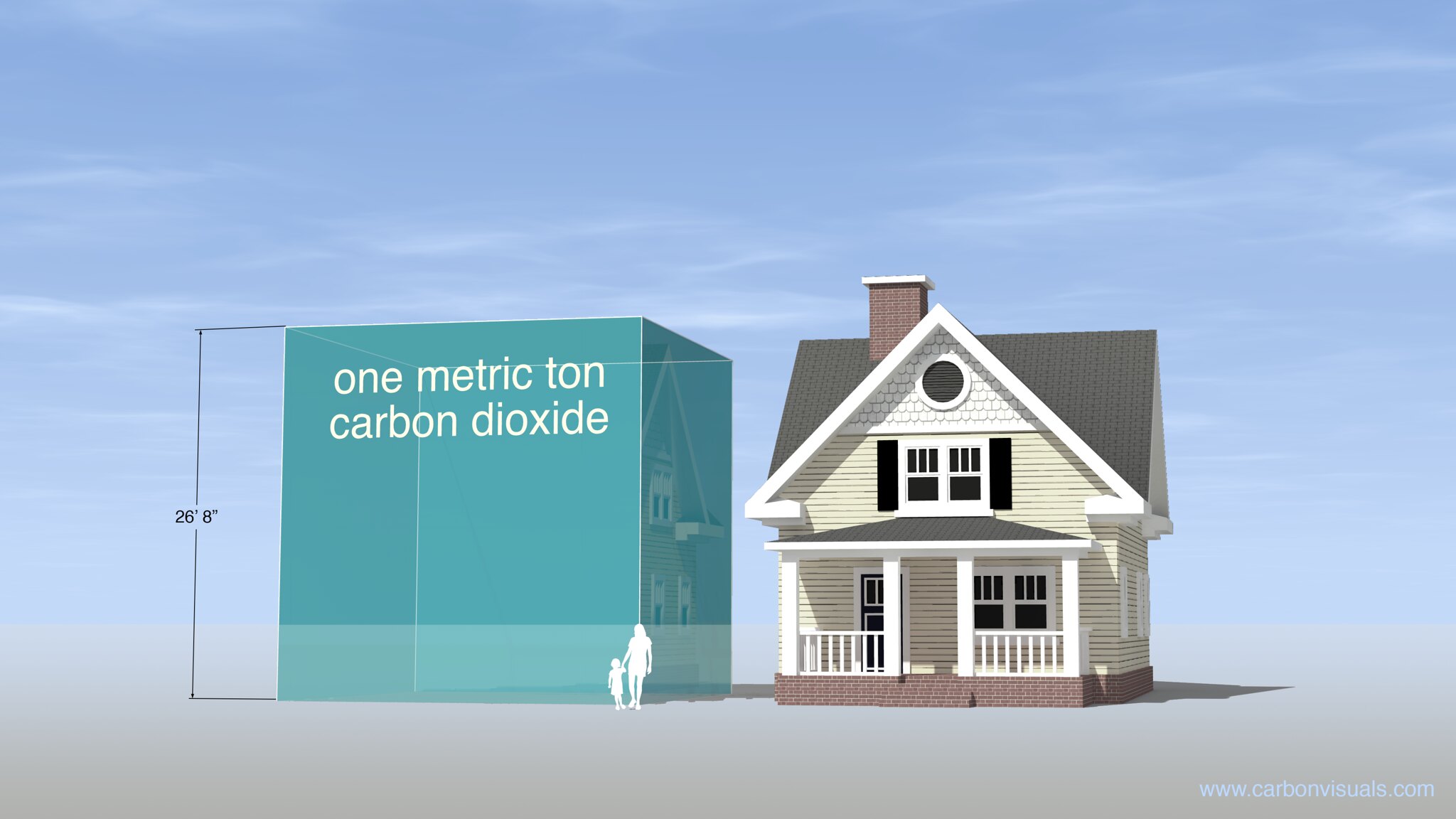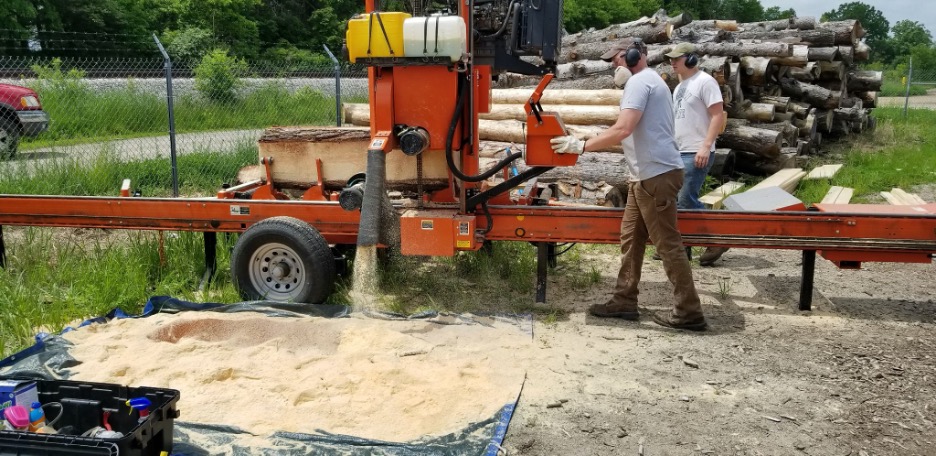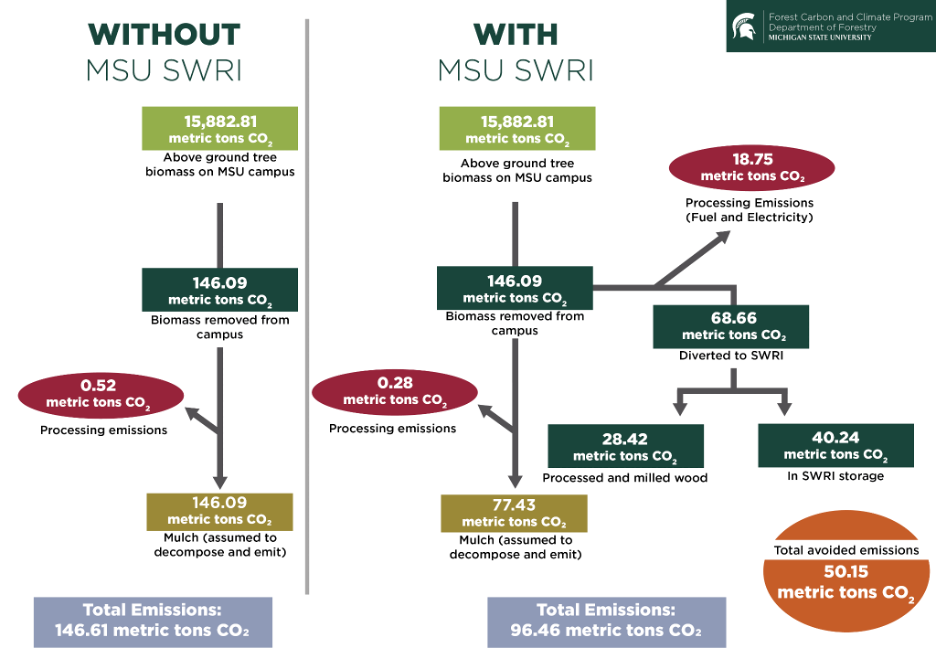Reducing campus carbon emissions with MSU trees
The MSU Sustainable Wood Recovery Initiative (SWRI) program reduced campus carbon dioxide emissions by 50.15 metric tons between 2015-2017.

When many of us think of college campuses, we envision a lush, green campus with majestic trees throughout. These trees are much more than aesthetically pleasing landscaping; these trees represent an important component of any campus’s climate change mitigation strategy. Trees have long been known to capture carbon dioxide - a major contributor to climate change- in the air and sequester that carbon in the biomass of the tree and produce oxygen as a byproduct. What happens then, when trees on campus reach the end of their life, sometimes from natural causes or need to be removed because of safety issues? Does this end mean the tree now represents a source of carbon dioxide emissions, both from the fuel burned in the machinery used removal process and when the tree is decomposing?
The Michigan State University Sustainable Wood Recovery Initiative (SWRI) program was founded precisely to address this issue, but it is not clear how successful this program has been in their mission until now. Christopher Merchant, a former Community Sustainability (CSUS), Environmental Studies and Sustainability major and employee at MSU Shadows, was frequently asked about the sustainability of the SWRI and chose to definitively answer this question as the focus of his undergraduate thesis research.
“When considering the sustainability of the program, we determined that SWRI had already demonstrated a degree of economic viability and cultural significance at the university, checking off the social and economic sustainability considerations; however, the environmental impact was not well understood. This resulted in the decision to attempt a carbon account,” says Merchant.
The study, led by Merchant in collaboration with CSUS faculty member Robby Richardson and Forestry faculty Lauren Cooper, Dan Brown, and Asia Dowtin, identified how successful the SWRI program is in reducing carbon dioxide emissions from the campus tree system. The researchers found between 2015 and 2017, SWRI reduced carbon dioxide emissions from the MSU tree removal process by around 47%.

During this time, the MSU campus redirected 68.66 metric tons of carbon dioxide. 28.42 metric tons of carbon dioxide were redirected into the MSU Shadows Collection wood products, and 40.24 tons of carbon dioxide were redirected in SWRI as raw lumber that is stored for future use.
“The main goal of the Sustainable Wood Recovery Initiative is to bring awareness to urban wood as a resource for construction of solid wood products. Some urban wood unfortunately ends up in a landfill or as low value mulch. None of these options are ideal for carbon sequestration. We strive to divert as much material as we can into solid wood products that will lock up carbon for as long as possible,” said Dan Brown, Coordinator of MSU Shadows and the SWRI.

The researchers estimate that without the SWRI, tree removal on MSU campus would have resulted in an additional 50.15 metric tons of carbon dioxide emissions.
To estimate just how much carbon dioxide emissions were offset by SWRI in comparison to former methods of tree disposal, Merchant and his colleagues began by calculating the captured carbon in the wood products created by SWRI minus the carbon dioxide emissions related to SWRI activities (harvesting and processing wood, running machinery, etc.).
To find an estimate of the unprocessed carbon dioxide that remained in the MSU SWRI, the total amounts of sawdust produced by the mill, waste wood after milling, and all usable wood after milling were measured.

Before 2014 when the SWRI program was introduced on campus, trees that needed to be felled because of natural causes such as age, storm damage, or disease were burned in coal biofuel mixture for energy production or used as landscaping mulch, both of which result in carbon dioxide emissions. In 2016, the T.B. Simon Power Plant changed its fuel source from coal to natural gas, and these trees were no longer used in energy production. Therefore, more of the removed trees were mulched and left to decompose, releasing carbon dioxide into the atmosphere. Merchant and his colleagues estimate in their report that this previous management strategy resulted in over 146.61 metric tons of carbon dioxide being released into the atmosphere.
By comparison, after the introduction of SWRI, from storage and lumber diverted to MSU Shadows, total campus emissions related to tree removal were reduced to 94.46 metric tons of carbon dioxide. From the ground tree biomass removed from campus, 68.66 metric tons of carbon dioxide were diverted to SWRI. Securing the carbon in the artisanal, handcrafted wooden products created by MSU Shadows alone prevented an estimated 28.42 metric tons of carbon dioxide emissions. The remaining 40.24 metric tons of carbon dioxide diverted to SWRI remains in the lumber now waiting to be used in future products.

Merchant says, “This research opens the door for more in-depth research into the value of introducing circularity into the waste stream at MSU. The SWRI is also of significant educational benefit as you can watch, in real time, as the staff turn rotting logs into high quality wood products. The findings from this study demonstrated that the program is likely a carbon sink.”
Products created through the SWRI are branded as the MSU Shadows Collection, and the funds raised support urban forestry education, tree plantings on campus, and the management of the program. Currently available items are shown on the MSU Surplus website. In addition, the collection can be seen throughout campus, like improving permanent structures within MSU.
“We have been innovative in creating fine furniture out of a resource that was previously relegated to mulch or firewood. We are one of only a handful of large institutions that have an urban wood use program. However, the movement is starting to catch on with a wider community. The urban wood network is now a national entity, whereas 5 years ago urban wood use was a loose collection of very small regional operations,” said Brown.
By showing effective management and utilization of campus trees, the MSU SWRI program provides ideas and opportunities for a greener future. Richardson says of the findings from this research, “Trees are an important part of the environmental legacy of the MSU campus, and efforts such as the SWRI program and the MSU Shadows Collection provide an exciting example of how university campuses and other urban environments can reduce emissions of CO2 from dead or dying trees removed from campus and use the wood to create beautiful furniture and other household, ornamental, and recreation products that sequester carbon and add value to the MSU Shadows Collection.”
Amy Butler, Director of Sustainability for MSU, says of this work, “A key aspect of our sustainability approach includes the use of the campus as a living laboratory, providing students an opportunity to conduct research and applied experiential learning that contribute to the campus sustainability. This research is a great example of how research, academics, and facilities work interactively to identify future strategies and actions that the university can both adopt and demonstrate as a part of our outreach mission.”
Understanding the social, economic and environmental impacts of the terrestrial ecosystem on campus is an important component of reducing carbon emissions and advancing MSU’s campus sustainability goals. Utilizing the collaborative framework of the four pillars of success: campus, curriculum, community, and culture, this work contributes towards maximizing its impact on its campus while minimizing its carbon footprint.



 Print
Print Email
Email




